StoryWeaver Spotlight: K. Suresh
Posted by Remya Padmadas on June 25, 2019K. Suresh likes to be known as a translator and has several books published for adults as well as children. He is one of the founders of Manchi Pustakam, a Trust for publishing and distributing children's books in Telugu. The organisation has more than 200 titles published by it and distributes an equal number of select books by other publishers. His emphasis is on books that create interest in and love for books among children. He feels that there is a great need for graded books that help children to increase their reading capacities. He has translated many stories to Telugu for Pratham Books including 'The Cat in the Ghat!' and 'What If?'. You can read his stories Mouse in the House and Lost and Found on StoryWeaver.

Q: What type of person do you think makes the best translator for children’s stories?
A person who loves books, likes children and respects them.
Q: Do you have any advice for anyone interested in becoming a translator?
A: The person should have good command over both the languages and should know the nuances. S/he should also know the cultural context and usage of idioms and phrases in both the languages. One should also read a lot.
The language for children should be simple. While translating one should use available vocabulary, though English words are commonly used. After completing the translation, give some gap and read it again without the source language text. Read it objectively, as if it was done by others and your job is to find errors in it.
Q: A book you'd like to recommend to other translators?
I suggest that the translators start with what they like and should feel that the children in the other language would miss a lot if that book isn’t translated. Obviously, I would suggest a book that I love very much.
Q: What is your personal relationship to language and/or translation?
I love to read books. I have started my work as a sub-editor in a Telugu newspaper, which involved translation and cultivated it over the years. I am not a creative writer, so I take pride in translation!
Q: When you’ve been given a story to translate, what’s your process, and how long does it generally take?
Sometimes I jump into translation. Sometimes, I read the entire story and sleep over it. While reading and in the free time, I think about the appropriate words and how it will be in Telugu.
Q: What do stories in translation bring to young readers?
It opens up their world! It introduces a new culture.
Q: You’ve translated stories for us. Which has been your favourite to work on?
I had the fortune of translating, reviewing and being a Guest Editor for Pratham Books. I liked translating The Cat in the Ghat!
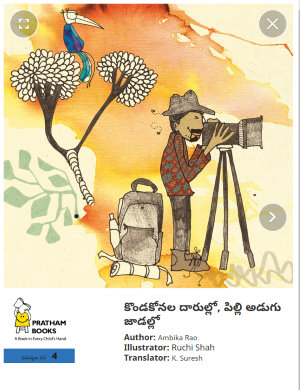
Q: What is the hardest thing about translating from English into Telugu? How do you navigate words or phrases that are tricky to translate?
The structure of English sentence is complex; it can take several adjectives and be very long. Breaking the sentences while translating sometimes results in losing the emphasis. The rhyming and punning with English words is difficult to translate. After the first translation, I explore simpler expressions and choice of vocabulary.
Q: How do you feel when your story reaches the child?
When we get to know that a child has enjoyed a story/ book we are very happy.
Q: Translating stories must have required research when it came to STEM related terms and concepts. How did you explore new objects and concepts?
For some words, I look up the dictionary. Sometimes re-writing helps. Constant reading will add to one’s vocabulary.
Q: How else do you think we can join hands to take more stories to more children in more languages?
Pratham Books and Tulika are doing excellent job in multi-language publications. StoryWeaver is providing a platform for exchange of books in various languages. Arvind Gupta is encouraging multi-language translations of children’s books and posting them on internet archive. Earlier there was considerable direct translation in regional languages, now English has become the connecting language. A publishers’ consortium for exchange of rights would be beneficial.
Q: As a publisher and translator what do you think is the best way to approach a child?
The general tendency is to preach to children, which I do not subscribe to. We expect lot from children without practising/ following them. The best way is to make a range of books available to children from which they can choose. We should not be overly worried about what they learn from a book. They will definitely learn from books and the society at large.
Be the first to comment.
StoryWeaver wins the mBillionth Awards 2019-2020!
Posted by Remya Padmadas on February 19, 2020Written by Pallavi Krishnan
We are incredibly proud to share that Pratham Books' StoryWeaver is a winner at the mBillionth Awards South Asia 2019-2020 in the Learning and Education category.

With the rapid increase in penetration of mobile technology across almost all socio-economic strata around the world, the mobile phone has emerged as the most powerful digital tool for empowerment across the world. This is more so in South Asia, Asia Pacific and other parts of the developing world.
Recognising this phenomenon, in 2010, Digital Empowerment Foundation (DEF) launched the mBillionth Awards South Asia to highlight, recognise, and reward best practices, excellence and innovations in the development and usage of mobile phone applications. With the theme of “Smart Phones to Smart Communities”, the award looks at mobile applications which can create transformative content and services and help engender remarkable and long-term changes in the lives and livelihoods of people, especially the underserved and socio-economically disadvantaged section.
The Learning and Education category recognises the use of mobile applications that empower the education sector and serve the needs of learners to acquire knowledge and skills. The aim is to identify and honour applications that try to transform schools, universities and other educational institutions through interactive, personalised and distributed learning resources; address the learning needs of all, and create active e-Learning communities.
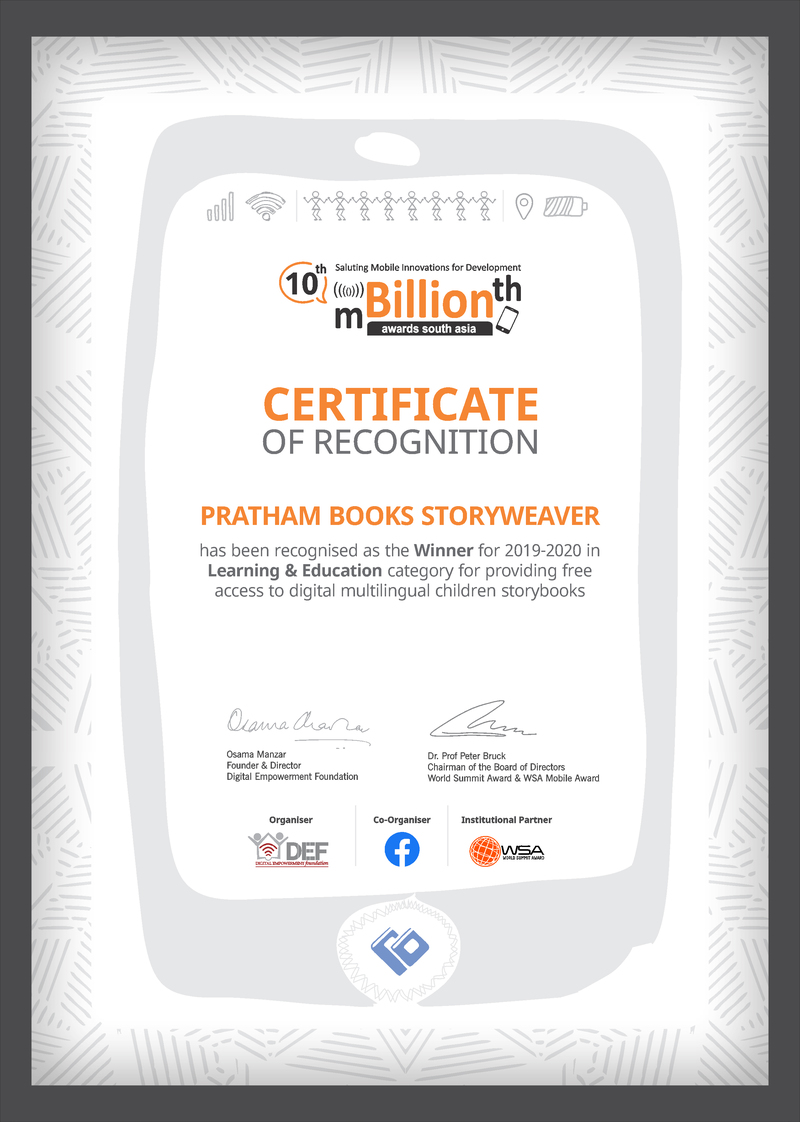
Suzanne Singh, Chairperson Pratham Books, Himanshu Giri, CEO Pratham Books and Anamika Radhakrishnan, Senior Product Manager, StoryWeaver attended the 10th mBillionth Award Gala 2019 at The Eros Hotel, Nehru Place, New Delhi on February 1st, 2020.
Be the first to comment.Stupendous Spiders
Posted by Remya Padmadas on February 28, 2018
The little creature with many eyes and legs lurking in the nooks and crannies of your house and garden has a fascinating story behind it. Vena Kapoor, Programme Co-ordinator, Education and Public Engagement at the Nature Conservation Foundation has been working in the areas of conservation research and practice since 1998. Her early research was on rainforest restoration in the Western Ghats using spiders as an indicator species and developing conservation education and outreach material. Vena has written 'Off to See Spiders' for Pratham Books, a digital first STEM book illustrated by Pia Meenakshi. This story first appeared in The Hindu in School dated September 16, 2015.
Eight legs and eight eyes
Spun a web and caught three flies -----
What comes to your mind when someone says the word “spider” to you? Long hairy legs and sticky webs? A scary little creature lurking in some deep dark corner?
If you, like many people, don't like spiders, that's quite understandable since spiders rarely get much positive press. But I can guarantee that if you make a little effort to get to know spiders better, you will gradually get fascinated – and may even end up a bit obses- sive about them, like I am!
First, find a spider in your home or outside. Now, does it sit in a web that resembles a wheel, or does the web look like a complicated mess? Web building spiders can take anywhere between 20 minutes to a full day to spin their miniature architectural marvels. In many species it is only the female who weaves a web, and the males (much smaller in size) hang out at the edges, hoping to scrounge a meal.
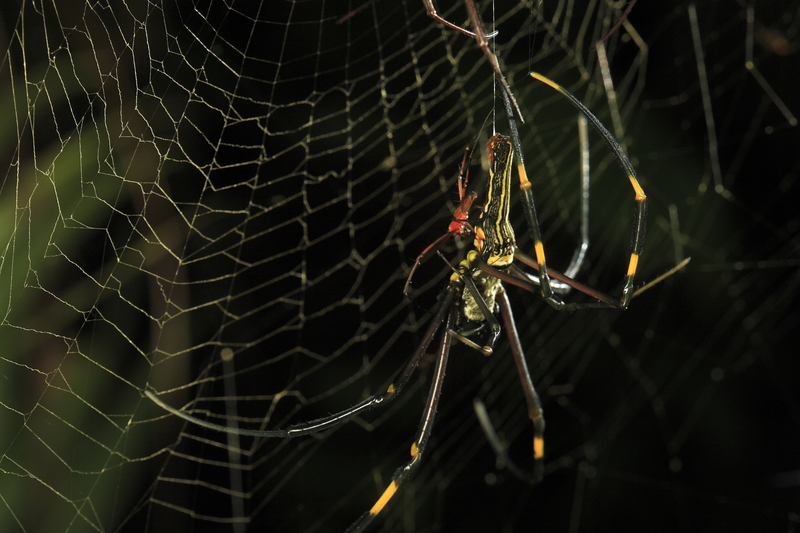
Femal Giant Wood Spider. Photograph by Sara.
Webs come in different shapes: a wheel, a dome, a thick white sheet, which becomes really prominent when there is heavy dew in the morning. Most spider webs are coated with a glue-like sub- stance to capture and hold steadfast any unfortunate insects that fly into them. Radiating lines of silk alert the waiting spider when something has been caught, else the poor-sighted spider might never know! A male web building spider strums and plucks the silk at the edge of the web to announce his arrival. If he is off-tune in his strumming the male is either ignored or eaten by the female!
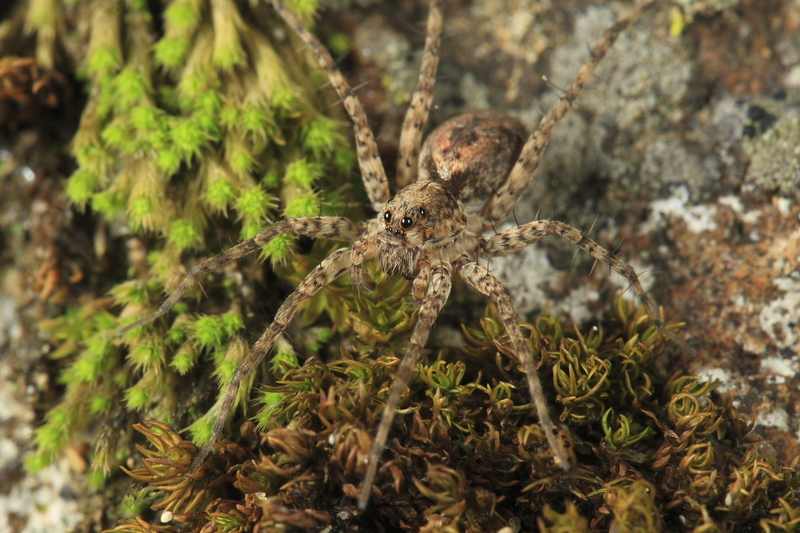
Wolf Spider. Photograph by Sara.
Perhaps you have come across a spider scurrying quickly about or jumping around athletically, with no web in sight? These spiders are known as hunting spiders and they rely on camouflage, stealth and deceit to get their food. Look for these spunky spiders in your house, on plants or on leaf litter on the ground. Sometimes looking closely at a flower will reveal a small brightly coloured spider that resembles a crab! These crab spiders often match the colour of the flower they live on; and an unsuspecting bee visiting the flower for nectar is soon made a meal of.
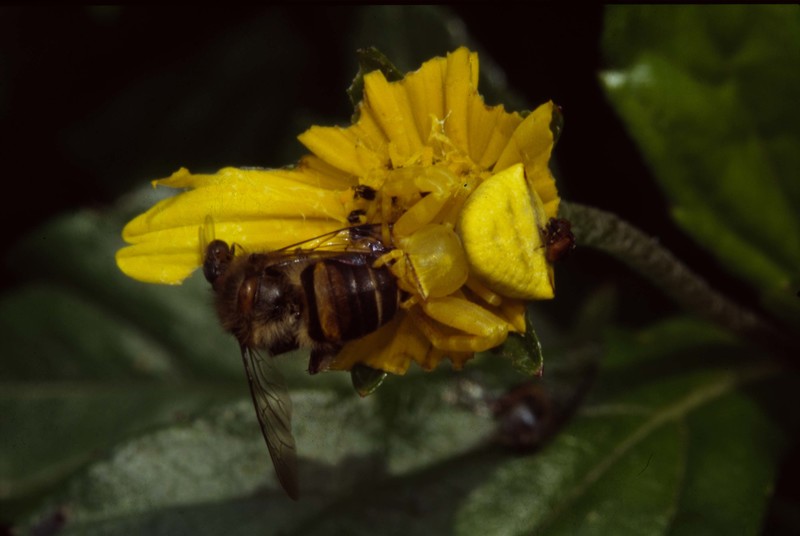
Crab Spider. Photograph by Robin Rozario.
Hunting spiders with their keener eyesight are also often brilliantly coloured, which helps to impress a female, since they have no webs to strum on. They often also perform elaborate courtship dances, which consist of swaying movements of their body and legs.
The world of spiders is weird and wonderful indeed. So the next time someone asks you if you would like to go bird watching, decline politely and tell them that you would rather go spider watching!
If you'd like to go on a spider walk right now, read Vena and Pia's book 'Off to See Spiders!' on StoryWeaver.
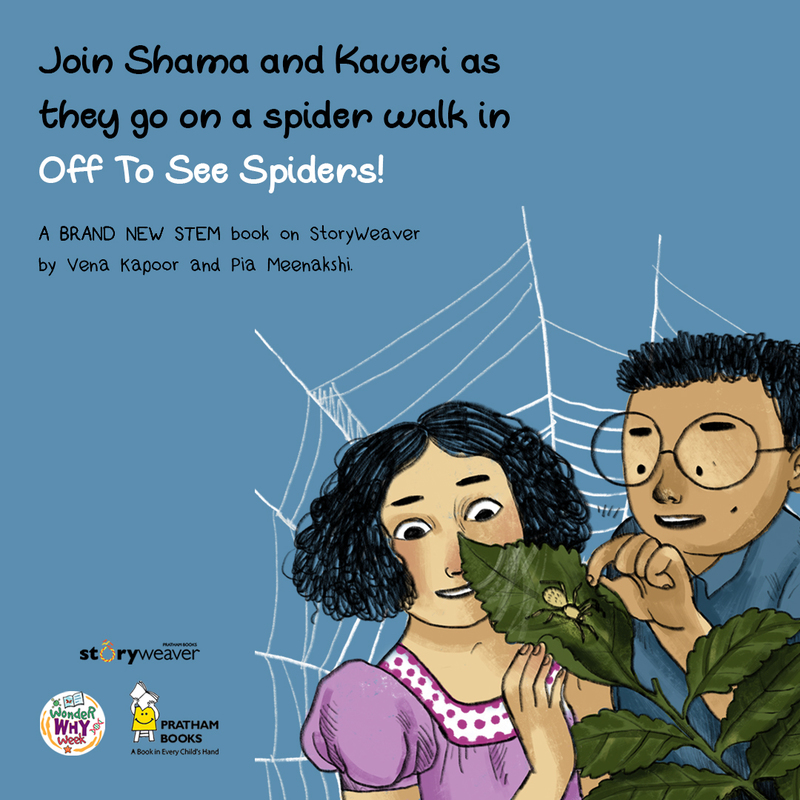
Be the first to comment.